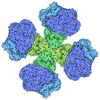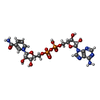+ データを開く
データを開く
- 基本情報
基本情報
| 登録情報 | データベース: PDB / ID: 8zc9 | ||||||||||||
|---|---|---|---|---|---|---|---|---|---|---|---|---|---|
| タイトル | The Cryo-EM structure of DSR2-Tail tube-NAD+ complex | ||||||||||||
 要素 要素 |
| ||||||||||||
 キーワード キーワード | IMMUNE SYSTEM / NADase / anti-phage defense / tail-tube protein / NAD | ||||||||||||
| 機能・相同性 | SIR2-like domain / SIR2-like domain / DHS-like NAD/FAD-binding domain superfamily / NICOTINAMIDE-ADENINE-DINUCLEOTIDE / Uncharacterized protein / SIR2-like domain-containing protein 機能・相同性情報 機能・相同性情報 | ||||||||||||
| 生物種 |  | ||||||||||||
| 手法 | 電子顕微鏡法 / 単粒子再構成法 / クライオ電子顕微鏡法 / 解像度: 3.14 Å | ||||||||||||
 データ登録者 データ登録者 | Wang, R. / Xu, Q. / Wu, Z. / Li, J. / Yang, R. / Shi, Z. / Li, F. | ||||||||||||
| 資金援助 |  中国, 3件 中国, 3件
| ||||||||||||
 引用 引用 |  ジャーナル: Nat Commun / 年: 2024 ジャーナル: Nat Commun / 年: 2024タイトル: The structural basis of the activation and inhibition of DSR2 NADase by phage proteins. 著者: Ruiwen Wang / Qi Xu / Zhuoxi Wu / Jialu Li / Hao Guo / Tianzhui Liao / Yuan Shi / Ling Yuan / Haishan Gao / Rong Yang / Zhubing Shi / Faxiang Li /  要旨: DSR2, a Sir2 domain-containing protein, protects bacteria from phage infection by hydrolyzing NAD. The enzymatic activity of DSR2 is triggered by the SPR phage tail tube protein (TTP), while ...DSR2, a Sir2 domain-containing protein, protects bacteria from phage infection by hydrolyzing NAD. The enzymatic activity of DSR2 is triggered by the SPR phage tail tube protein (TTP), while suppressed by the SPbeta phage-encoded DSAD1 protein, enabling phages to evade the host defense. However, the molecular mechanisms of activation and inhibition of DSR2 remain elusive. Here, we report the cryo-EM structures of apo DSR2, DSR2-TTP-NAD and DSR2-DSAD1 complexes. DSR2 assembles into a head-to-head tetramer mediated by its Sir2 domain. The C-terminal helical regions of DSR2 constitute four partner-binding cavities with opened and closed conformation. Two TTP molecules bind to two of the four C-terminal cavities, inducing conformational change of Sir2 domain to activate DSR2. Furthermore, DSAD1 competes with the activator for binding to the C-terminal cavity of DSR2, effectively suppressing its enzymatic activity. Our results provide the mechanistic insights into the DSR2-mediated anti-phage defense system and DSAD1-dependent phage immune evasion. | ||||||||||||
| 履歴 |
|
- 構造の表示
構造の表示
| 構造ビューア | 分子:  Molmil Molmil Jmol/JSmol Jmol/JSmol |
|---|
- ダウンロードとリンク
ダウンロードとリンク
- ダウンロード
ダウンロード
| PDBx/mmCIF形式 |  8zc9.cif.gz 8zc9.cif.gz | 1 MB | 表示 |  PDBx/mmCIF形式 PDBx/mmCIF形式 |
|---|---|---|---|---|
| PDB形式 |  pdb8zc9.ent.gz pdb8zc9.ent.gz | 706.6 KB | 表示 |  PDB形式 PDB形式 |
| PDBx/mmJSON形式 |  8zc9.json.gz 8zc9.json.gz | ツリー表示 |  PDBx/mmJSON形式 PDBx/mmJSON形式 | |
| その他 |  その他のダウンロード その他のダウンロード |
-検証レポート
| 文書・要旨 |  8zc9_validation.pdf.gz 8zc9_validation.pdf.gz | 1.2 MB | 表示 |  wwPDB検証レポート wwPDB検証レポート |
|---|---|---|---|---|
| 文書・詳細版 |  8zc9_full_validation.pdf.gz 8zc9_full_validation.pdf.gz | 1.4 MB | 表示 | |
| XML形式データ |  8zc9_validation.xml.gz 8zc9_validation.xml.gz | 127 KB | 表示 | |
| CIF形式データ |  8zc9_validation.cif.gz 8zc9_validation.cif.gz | 188.2 KB | 表示 | |
| アーカイブディレクトリ |  https://data.pdbj.org/pub/pdb/validation_reports/zc/8zc9 https://data.pdbj.org/pub/pdb/validation_reports/zc/8zc9 ftp://data.pdbj.org/pub/pdb/validation_reports/zc/8zc9 ftp://data.pdbj.org/pub/pdb/validation_reports/zc/8zc9 | HTTPS FTP |
-関連構造データ
| 関連構造データ |  39925MC 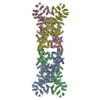 8y13C 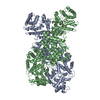 8y34C  8y3mC 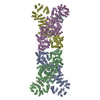 8y3wC 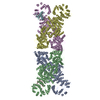 8y3yC C: 同じ文献を引用 ( M: このデータのモデリングに利用したマップデータ |
|---|---|
| 類似構造データ | 類似検索 - 機能・相同性  F&H 検索 F&H 検索 |
- リンク
リンク
- 集合体
集合体
| 登録構造単位 | 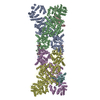
|
|---|---|
| 1 |
|
- 要素
要素
| #1: タンパク質 | 分子量: 118568.727 Da / 分子数: 4 / 由来タイプ: 組換発現 詳細: The sequence of organism Bacillus subtilis is not available, replaced by D4G637 temporarily. 由来: (組換発現)   #2: タンパク質 | 分子量: 29304.701 Da / 分子数: 2 / 由来タイプ: 組換発現 / 由来: (組換発現)   #3: 化合物 | ChemComp-NAD / 研究の焦点であるリガンドがあるか | Y | |
|---|
-実験情報
-実験
| 実験 | 手法: 電子顕微鏡法 |
|---|---|
| EM実験 | 試料の集合状態: PARTICLE / 3次元再構成法: 単粒子再構成法 |
- 試料調製
試料調製
| 構成要素 | 名称: DSR2-tail tube protein-NAD+ complex / タイプ: COMPLEX / Entity ID: #1-#2 / 由来: RECOMBINANT | ||||||||||||||||||||
|---|---|---|---|---|---|---|---|---|---|---|---|---|---|---|---|---|---|---|---|---|---|
| 由来(天然) | 生物種:  | ||||||||||||||||||||
| 由来(組換発現) | 生物種:  | ||||||||||||||||||||
| 緩衝液 | pH: 7.5 / 詳細: 20 mM HEPES pH 7.5, 100 mM NaCl, 0.5 mM TCEP | ||||||||||||||||||||
| 緩衝液成分 |
| ||||||||||||||||||||
| 試料 | 包埋: NO / シャドウイング: NO / 染色: NO / 凍結: YES / 詳細: 10mg/ml | ||||||||||||||||||||
| 試料支持 | グリッドの材料: COPPER / グリッドのサイズ: 300 divisions/in. / グリッドのタイプ: Quantifoil R1.2/1.3 | ||||||||||||||||||||
| 急速凍結 | 装置: FEI VITROBOT MARK I / 凍結剤: ETHANE / 湿度: 100 % |
- 電子顕微鏡撮影
電子顕微鏡撮影
| 実験機器 |  モデル: Titan Krios / 画像提供: FEI Company |
|---|---|
| 顕微鏡 | モデル: FEI TITAN KRIOS |
| 電子銃 | 電子線源:  FIELD EMISSION GUN / 加速電圧: 300 kV / 照射モード: FLOOD BEAM FIELD EMISSION GUN / 加速電圧: 300 kV / 照射モード: FLOOD BEAM |
| 電子レンズ | モード: BRIGHT FIELD / 倍率(公称値): 105000 X / 最大 デフォーカス(公称値): 2000 nm / 最小 デフォーカス(公称値): 1500 nm / Cs: 2.7 mm / C2レンズ絞り径: 50 µm |
| 試料ホルダ | 試料ホルダーモデル: FEI TITAN KRIOS AUTOGRID HOLDER |
| 撮影 | 電子線照射量: 50 e/Å2 フィルム・検出器のモデル: FEI FALCON IV (4k x 4k) |
- 解析
解析
| CTF補正 | タイプ: NONE | ||||||||||||||||||||||||
|---|---|---|---|---|---|---|---|---|---|---|---|---|---|---|---|---|---|---|---|---|---|---|---|---|---|
| 粒子像の選択 | 選択した粒子像数: 3383 | ||||||||||||||||||||||||
| 3次元再構成 | 解像度: 3.14 Å / 解像度の算出法: FSC 0.143 CUT-OFF / 粒子像の数: 57864 / 対称性のタイプ: POINT | ||||||||||||||||||||||||
| 原子モデル構築 | B value: 116 | ||||||||||||||||||||||||
| 精密化 | 交差検証法: NONE 立体化学のターゲット値: GeoStd + Monomer Library + CDL v1.2 | ||||||||||||||||||||||||
| 原子変位パラメータ | Biso mean: 126.31 Å2 | ||||||||||||||||||||||||
| 拘束条件 |
|
 ムービー
ムービー コントローラー
コントローラー





















 PDBj
PDBj
